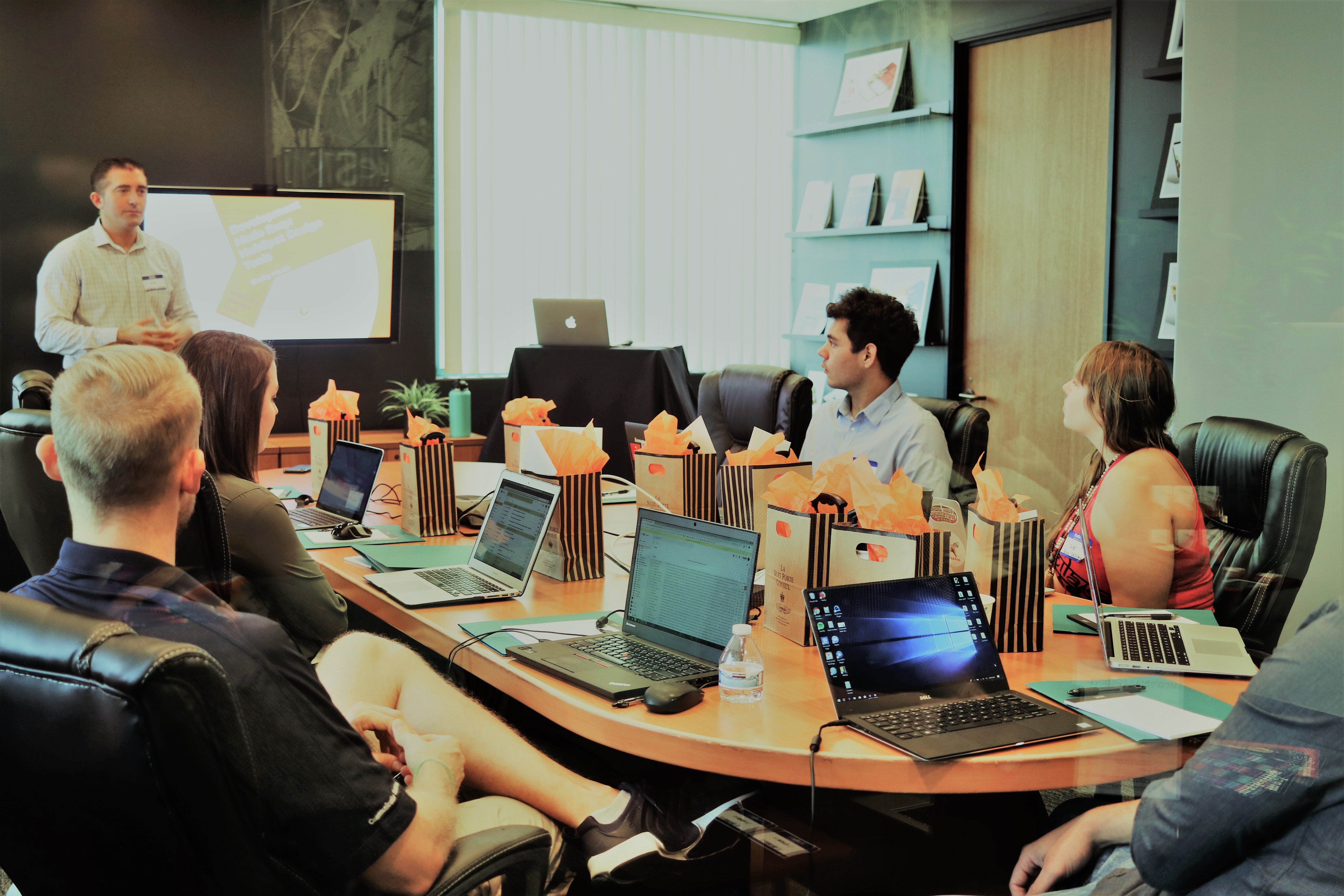
Effective Webinar Presentation Skills Every Expert Should Master
Why Experts Should Master Webinar Presentation Skills
Webinars have been around for more than 15 years and they are still one of the strongest tools for experts to use in their business development and online education efforts. According to ON24’s 2019 Webinar Benchmarks Report, 95% of their respondents agreed that webinars are a key component of their marketing efforts. In GoToWebinar’s 2019 report, The Big Book of Webinar Stats, 95% of respondents said webinars improved marketing performance and learning retention.
The truth is, most webinars are still presented by marketing teams, and part of their know-how includes presentation skills. So if you’ve been tasked with providing webinars for business development or online education, odds are it’s something you only do a few times a year, and not necessarily a skill set you’ve had a chance to fully develop.
A webinar lets you showcase your wisdom and insight with a captive audience for an average of 45 minutes. It’s important to make the most of that time by building a connection in a virtual environment. And there are important skills to develop in order to turn a presentation into quality follow-up conversations, or to have a positive affect on customer success.
Create a Webinar Project Timeline
Wait, aren’t we talking about presentation skills? What does a project timeline have to do with presenting? Well, experts in every industry face the same challenge: a calendar overflowing with meetings, projects and schedule changes. A webinar event can easily slip through the cracks and suddenly you find yourself with a week to prepare content, slap a PowerPoint together, and *maybe* do a dry run. This does not bode well for a world-class webinar. Adequate time spent in creating valuable content and a polished presentation will have a positive affect on how a virtual audience reacts to the presentation and whether they are open to connecting after the event.
A well-executed webinar does require proper planning. A simple webinar project timeline will help determine the actual time that needs to be invested and keep you on target. Here’s what to consider in the timeline:
Start with the webinar date
If possible, choose a window of two months. Set the webinar date near the end of two months and then work backwards on the timeline.
Schedule a dry run
Set the dry run for a week prior to the live event and make sure it’s already on the calendar. This gives adequate time to make any adjustments and fine-tune your presentation. Record the dry run to get a sense of sound quality and flow. A USB headset is always best for virtual presentations.
Create the slide deck
Set the date for when the slide deck should be completed. It’s best to have it done by the dry run. Allow time for review from peers or if presentations need sign-off and editing from other departments like Marketing.
Develop the outline for the content
Determine when the outline of the presentation should be completed so that it can then be fully fleshed out into a slide deck. Note that creating a slide deck usually takes the most time!
Develop Educational Content
I truly believe that most experts are natural educators. But there are several best practices in creating content geared towards the learning styles of adults especially in a virtual environment. Things to keep in mind when developing your educational content:
- Start by taking a moment to describe your ideal audience. This helps to determine what is most important to a specific group and how to best impart that information: Do they prefer statistics and numbers? Are they more visual and creative? Have they already had exposure to the topic in some way? Are they executive or mid level in their role?
- Keep the presentation topic fairly high level or narrow it down to something specific. Simply put, avoid cramming a bunch of information into the presentation because all of it seems important. When the topic is kept simple, it’s easier for people to absorb and retain the information within 45 minutes. For more complex subjects, break them into a series of webinars.
- Determine 2-3 outcomes of the presentation: What change might the audience experience after participating? What skills or new learning will they be able to apply and how will they apply it? As the content gets developed, the 2-3 outcomes should be the guidepost in determining which points are important and relevant. Here is an example of descriptive outcomes:
Listen to examples of communicating with confidence.
Utilize the art of asking questions to elicit more from others.
Develop a script to help you give your best first impression.
- Finally, the most interesting webinars include case studies, client success stories, personal anecdotes, and how-to’s.
Create a Compelling Slide Deck
I do roughly 60 webinars every year. That includes my own webinars and those I consult on. One of the improvements I’d love to see is the quality of presentation decks. I get it, not everyone is a graphic designer, but the value of presenting a classy, well put together deck not only showcases professionalism, but it absolutely enhances the ability for participants to remember the information being presented. Here’s what to keep in mind when building an effective presentation deck:
- The aspect ratio of a PowerPoint deck should be widescreen, 16:9.
- Slides are meant to display jumping off points, imagery to complement ideas and elicit emotions, relevant data like graphs and charts, and guideposts around the topic. They are not meant to be read like a document. Place detailed information into a handout.
- Short, high-level phrases are easiest to remember. One phrase per slide is best. Yes, this creates a much bigger slide deck but the presentation should be kept moving.
- When using images, fill the whole slide with the image for greater impact.
- Consider nixing all bullet points! I have done this and my slides look so much cleaner and more modern now.
- Remember to be inclusive. When using visuals and stories, be sure to include images that reflect various races, genders, ages, cultures, abilities, etc. There are so many groups who have been wanting to be truly seen, represented, and heard since time began. Let’s all be mindful of that going forward.
- My favorite site to visit and ogle presentation decks for inspiration is SlideShare.
- Lastly, consider creating an infographic! Here’s a how-to from HubSpot on creating an infographic in PowerPoint. You can also find infographic templates on Canva.com. After saving the infographic as a PNG file, you can post it on social media as a follow-up to the webinar (see the one I created in Canva below).
Include Interaction In The Presentation
Anyone who reads my webinar best practices knows I’m all about creating interaction and engagement in my webinar events. I probably sound like a broken record, but it’s so important to connect with a virtual audience and build trust and connection, especially if there are plans to follow-up with participants. When building interaction into the presentation, consider the following:
- Read comments out loud from the audience and include the participant’s first name.
- Team up with a colleague to co-present and give a more conversational tone to your presentation.
- Present a problem, provide education around solutions, and include the audience in solving the problem.
For more ideas on creating interaction, here are 5 Creative Ideas To Improve Webinar Audience Engagement.
Ask Quality, Open-ended Questions
Most webinar events leave Q&A until the end and then there’s a round of “Any questions?” followed by a few minutes of dead air. In this scenario, it’s challenging to get engagement and there’s very little data to use when following up with prospects.
Allowing the audience to think about and respond to open-ended questions addresses how adults learn best. It helps them feel included, especially in a virtual environment. It can also spark interesting conversations. In addition, any comments provided by the audience, whether through the chat or Q&A function, will be captured in a report that can be used for follow-up conversations later.
A valuable habit to develop is to prepare quality, open-ended questions to pepper the presentation with. Here are some examples of changing yes/no questions to open-ended ones:
- Do you participate in regular networking? Change to: What is your definition of effective networking?
- Can you tell if a startup has the potential to be profitable? Change to: How do you know if a startup has the potential to be an enduring $1 Billion dollar company?
- Does your company offer anything for free to clients? Change to: What was the last thing your company offered clients for free?
- Did you find this webinar beneficial? Change to: What is the first thing you will change after having participated in this webinar?
In reading these examples, how might open-ended questions affect the types of responses you would get instead of yes/no ones?
Wrapping Up
When it comes to effective webinar presentation skills, my recommendations are focused on content design which includes understanding who your ideal audience is, developing educational content geared toward that group, and then including that audience in your presentation so that you build connection in a virtual environment.
Don’t be fooled by how much time it takes to put together a world-class webinar. A webinar project timeline ensures that you have given yourself enough time to develop content, create a professional slide deck, and run a practice session. Once you get the hang of this, it will be a valuable skill set you can easily repeat.
Here’s an infographic with the highlights from this article. Hover over the image to share it!

Here’s to your success!
~ Corena
Corena Bahr is a webinar expert, speaker, and trainer helping experts at corporations and global firms deliver world-class webinars for client outreach and customer success. She teaches experts how to create a human connection with a virtual audience, structure content for engagement, and how to use the “bells & whistles” of webinar platforms to drive business goals. Corena is also a LinkedIn Learning course author.



